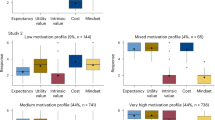Abstract
While several authors have examined gender as a determinant of student performance in introductory economics, few have considered race as a contributing factor. In this study, data collected on over 5,000 students enrolled at the University of Texas at Austin indicate that on average minority students earn significantly lower grades than non-minority students. A probit model is developed to control for a set of variables that measure or proxy student characteristics, academic maturity, previous coursework, and relative high school quality. Race remains statistically significant. A decomposition framework, commonly used in labor economics to study wage gaps, is adapted to predict success in economics classes based on mean variable characteristics. Details on the probabilities of earning specific grades are obtained through development of an ordered logit model and decomposition techniques. Results of these analyses indicate significant and unexplained differences in average grades earned by minority students, relative to non-minority students.
Similar content being viewed by others
Notes
In this study, the term “minority” refers those groups that are traditionally under-represented in academia as a proportion of the population. Minorities include U.S. citizens and permanent residents who self-identify as African American, Hispanic or Native American. Non-minorities include International students or U.S. citizens and permanent residents who self-identify as White or Asian American. Data from the 1990 Census, Equal Employment Opportunity File, indicate five percent of economics teachers in U.S. Post-Secondary Institutions are African American and Hispanic (none are Native American), while these groups represented over 21% of the U.S. population. Asian Americans constitute less than three percent of the U.S. population and over 7% of economics teachers in higher education.
References
Acs G, Danziger S. Educational attainment, industrial structure, and male earnings through the 1980s. J Hum Resour. 1993;28(3):618–49.
Anderson G, Benjamin D, Fuss MA. The determinants of success in university introductory economics courses. J Econ Educ. 1994;25(2):99–119.
Andrews RJ. High school quality, race, and college achievement. THEOP Working Paper, presented at the THEOP Research Conference, Princeton, NJ; August 2008. Retrieved September 9, 2009 from http://www.texastop10.princeton.edu/publications/wp.asp.
Bartlett RL. Attracting ‘otherwise bright students’ to economics 101. Am Econ Rev. 1995;85(2):362–6.
Borg MO, Shapiro SL. Personality type and student performance in principles of economics. J Econ Educ. 1996;27(1):3–24.
Borg MO, Stranahan HA. The effect of gender and race on student performance in principles of economics: the importance of personality type. Appl Econ. 2002a;34:589–98.
Borg MO, Stranahan HA. Personality type and student performance in upper-level economics courses: the importance of race and gender. J Econ Educ. 2002b;33(1):3–14.
Brasfield DW, McCoy JP, Milkman M. The effect of university math on student performance in principles of economics. J Res Dev Educ. 1992;24(4):240–7.
Catanese AV. Faculty role models and diversifying the gender and racial mix of undergraduate economics majors. J Econ Educ. 1991;22(3):276–84.
Collins SM. Report of the committee on the status of minority groups in the economics profession. Am Econ Rev. 1997;87(2):502–5.
Corcoran M, Duncan GJ. Work history, labor force attachment, and earnings differences between the races and sexes. J Hum Resour. 1979;XIV(1):3–20.
Dynan KE, Rouse CE. The underrepresentation of women in economics: a study of undergraduate economics students. J Econ Educ. 1997;28(4):350–69.
Greene WH. Econometric analysis. 3rd ed. Upper Saddle River, New Jersey: Prentice Hall; 1997.
Grove WA, Wasserman T, Grodner A. Choosing a proxy for academic aptitutde. J Econ Educ. 2006;37(2):131–47.
Horvath J, Beaudin BQ, Wright SP. Persisting in the introductory economics course: an exploration of gender differences. J Econ Educ. 1992;23(2):101–8.
Kennedy PE, Siegfried JJ. Class size and achievement in introductory economics: evidence from the TUCE III data. Econ Educ Rev. 1997;16(4):385–94.
Lopus JS. Effects of the high school economics curriculum on learning in the college principles class. J Econ Educ. 1997;28(2):143–53.
Maddala GS. Econometrics. New York: McGraw Hill; 1977.
Marlin JW Jr, Durden GC. An analysis of contributions and contributors in economic education research. J Econ Educ. 1993;24(2):171–86.
McCoy JP, Brasfield DW, Milkman M. The impact of macro/micro course sequencing. J Educ Bus. 1991;66(4):223–7.
Oaxaca R. Male-female wage differentials in urban labor markets. Int Econ Rev. 1973;14(3):693–709.
Oaxaca RL, Ransom MR. On discrimination and the decomposition of wage differentials. J Econom. 1994;61:5–21.
Raimondo HJ, Esposito L, Gershenberg I. Introductory class size and student performance in intermediate theory courses. J Econ Educ. 1990;21:369–81.
Rask KN, Bailey EM. Are faculty role models? Evidence from major choice in an undergraduate institution. J Econ Educ. 2002;33:99–124.
Rouse CE. Report of the committee on the status of minority groups in the economics profession. Am Econ Rev Pap Proc. 2009;99(2):700–9.
Siegfried JJ. Male–female differences in economic education: a survey. J Econ Educ. 1979;10:1–11.
Siegfried JJ, Fels R. Research on teaching college economics: a survey. J Econ Lit. 1979;XVII(3):923–69.
Siegfried JJ, Bartlett RL, Lee Hansen W, Kelley AC, McCloskey DN, Tietenburg TH. The status and prospects of the economics major. J Econ Educ. 1991;22(3):197–224.
Smith TM, Rogers GT, Alsalam A, Perie M, Mahoney RP, Martin V. The condition of education 1984. Washington: National Center for Education Statistics; 1984.
Author information
Authors and Affiliations
Corresponding author
About this article
Cite this article
Stockly, S.K. Is Race a Determinant of Student Performance in Economics?. Rev Black Polit Econ 36, 181–195 (2009). https://doi.org/10.1007/s12114-009-9046-2
Received:
Accepted:
Published:
Issue Date:
DOI: https://doi.org/10.1007/s12114-009-9046-2




